Olive
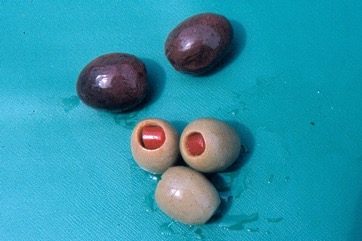
It suits warm temperate, subtropical and Mediterranean climates. Olive require a long hot growing season to properly ripen the fruit. They also need sufficient winter chill to insure fruit set. It can grow in regions with temperature ranges from 7-35°C. Plants can survive frosts but green fruit can be damaged as -2°C. Trees are wind tolerant. Olives can grow on any well drained soil up to pH 8.5. A pH of 6.5-7.5 is ideal. They can tolerate mild saline conditions. In India it grows as 750-1450 m altitude. It grows in Miombo woodland in Africa. It suits hardiness zones 8-10. In Sichuan and Yunnan.
Also known as:
Acebuche, Aceituna, Gan lan, Manzanillo, Molialundi, Muthata, Mu xi lan, Olivenbaum, Olivier, Olivo, 'Oliwa, Olibu, Ulivo, Tahatimt, Zaitun, Zeitun, Zeytin
Synonyms
- Olea africana Mill.
Edible Portion
- Fruit, Herb, Spice, Manna, Leaves, Oil
Where does Olive grow?
Found in: Africa, Albania, Algeria, Angola, Argentina, Asia, Australia, Azerbaijan, Bermuda, Britain, Burundi, Caucasus, Central Africa, Chile, China, Congo, Croatia, Cuba, Cyprus, East Africa, Egypt, Eritrea, Ethiopia, Europe, France, Greece, Hawaii, India, Iran, Israel, Italy, Jordan, Kenya, Korea, Lebanon, Libya, Macedonia, Malawi, Mali, Marquesas, Mauritania, Mauritius, Mediterranean, Mexico, Middle East, Montenegro, Morocco, Mozambique, Namibia, New Zealand, Nigeria, North Africa, North America, Oman, Pacific, Pakistan, Palestine, Papua New Guinea, PNG, Peru, Portugal, Rwanda, San Marino, Sao Tome and Principe, Saudi Arabia, Senegal, Slovenia, Somalia, Southern Africa, South America, Spain, St Helena, Sudan, Syria, Taiwan, Tanzania, Tasmania, Tibet, Tunisia, Turkey, Uganda, United States, West Africa, Yugoslavia, Zambia, Zimbabwe
Notes: There are over 20-40 Olea species.
Growing Olive
Cultivation: Growing trees from seed mean they revert to wild small fruited kinds. Seed are poorly viable and may take 2 years to germinate. Normally trees are grown by budding or grafting. Suckers can be used but these may be wild seedling kinds. Trees can be grown from cuttings. Cuttings 30-35 cm long and 3-8 cm thick from 2 year old wood are used with rooting hormone. Thinning the crop can increase fruit size. Thinning to 2-3 fruit per twig is best. Pruning both regulates growth and shapes the tree. Careful pruning can avoid bearing in alternate years. Olives never bear fruit in the same place twice and normally produce on the previous year's growth. Many varieties are self-sterile and need suitable cross pollinators.
Edible Uses: The ripe fruit is used after being pickled or preserved. It is also used for oil. Raw fruit contain an alkaloid making them bitter and unpalatable. This is removed by lye curing (1.3-2% caustic soda), then washing with water and then transferring to a saline solution. The tree is the source of an edible manna.
Production: Trees can reach bearing age in about 4 years. Trees can live for 500 years. Green olives are picked unripe, black olives when ripe.
Nutrition Info
per 100g edible portion| Edible Part | Energy (kcal) | Protein (g) | Iron (mg) | Vitamin A (ug) | Vitamin c (mg) | Zinc (mg) | % Water |
|---|---|---|---|---|---|---|---|
| Fruit - ripe | 115 | 0.84 | 1.6 | 40 | 0.9 | 0.2 | 80 |
Olive Photos

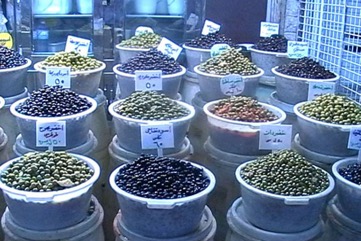
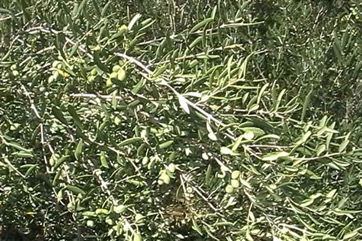
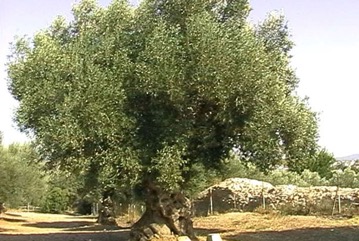
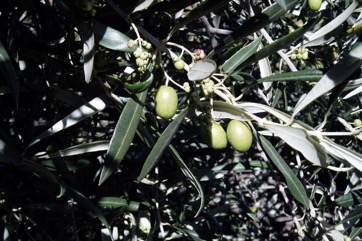
References
Ambasta, S.P. (Ed.), 2000, The Useful Plants of India. CSIR India. p 407
Blamey, M and Grey-Wilson, C., 2005, Wild flowers of the Mediterranean. A & C Black London. p 174
Bodkin, F., 1991, Encyclopedia Botanica. Cornstalk publishing, p 736
Bremness, L., 1994, Herbs. Collins Eyewitness Handbooks. Harper Collins. p 69
Brickell, C. (Ed.), 1999, The Royal Horticultural Society A-Z Encyclopedia of Garden Plants. Convent Garden Books. p 718
Burkill, H. M., 1985, The useful plants of west tropical Africa, Vol. 5. Kew.
Burkill, I.H., 1966, A Dictionary of the Economic Products of the Malay Peninsula. Ministry of Agriculture and Cooperatives, Kuala Lumpur, Malaysia. Vol 2 (I-Z) p 1607
Cerne, M., 1992, Wild Plants from Slovenia used as Vegetables. Acta Horticulturae 318
Cheifetz, A., (ed), 1999, 500 popular vegetables, herbs, fruits and nuts for Australian Gardeners. Random House p 212
Chang Mei-chen, Qiu Lian-qing, Green, P.S., Oleaceae. Flora of China.
Ciftcioglu, C. G., 2015, Sustainable wild-collection of medicinal and edible plants in Lefke region of North Cyprus. Agroforest Syst. Springer
Cundall, P., (ed.), 2004, Gardening Australia: flora: the gardener's bible. ABC Books. p 948
Dashorst, G.R.M., and Jessop, J.P., 1998, Plants of the Adelaide Plains & Hills. Botanic Gardens of Adelaide and State Herbarium. p 118
Ertug, F, Yenen Bitkiler. Resimli Türkiye Florası -I- Flora of Turkey - Ethnobotany supplement
Etherington, K., & Imwold, D., (Eds), 2001, Botanica's Trees & Shrubs. The illustrated A-Z of over 8500 trees and shrubs. Random House, Australia. p 498
Facciola, S., 1998, Cornucopia 2: a Source Book of Edible Plants. Kampong Publications, p 163
Flora of Pakistan. www.eFloras.org
Flowerdew, B., 2000, Complete Fruit Book. Kyle Cathie Ltd., London. p 132
Gurdal, B. & Kultur, S., 2014, The edible and miscellaneous useful plants in Marmaris (Southwest Turkey). İstanbul Ecz. Fak. Derg. / J. Fac. Pharm. Istanbul 44(1) 2014 pp.69-78
Hall, N. et al, 1972, The Use of Trees and Shrubs in the Dry Country of Australia, AGPS, Canberra. p 393
Hedrick, U.P., 1919, (Ed.), Sturtevant's edible plants of the world. p 446
Hibbert, M., 2002, The Aussie Plant Finder 2002, Florilegium. p 213
Hines, D. A. & Eckman, K., 1993, Indigenous multipurpose trees of Tanzania: Uses and economic benefits for people. FAO Forestry Department. p 191
http://www.botanic-gardens-ljubljana.com/en/plants
Hussey, B.M.J., Keighery, G.J., Cousens, R.D., Dodd, J., Lloyd, S.G., 1997, Western Weeds. A guide to the weeds of Western Australia. Plant Protection Society of Western Australia. p 186
Hu, Shiu-ying, 2005, Food Plants of China. The Chinese University Press. p 627
Jardin, C., 1970, List of Foods Used In Africa, FAO Nutrition Information Document Series No 2.p 150
John, L., & Stevenson, V., 1979, The Complete Book of Fruit. Angus & Robertson p 203
Khan, D. & Shaukat, S.S., 2006, The Fruits of Pakistan: Diversity, Distribution, Trends of Production and Use. Int. J. Biol. Biotech., 3(3):463-499
Kiple, K.F. & Ornelas, K.C., (eds), 2000, The Cambridge World History of Food. CUP p 433, 1825
Krishen P., 2006, Trees of Delhi, A Field Guide. DK Books. p 177
Kybal, J., 1980, Herbs and Spices, A Hamlyn Colour Guide, Hamlyn Sydney p 142
Lazarides, M. & Hince, B., 1993, Handbook of Economic Plants of Australia, CSIRO. p 173
Lord, E.E., & Willis, J.H., 1999, Shrubs and Trees for Australian gardens. Lothian. p 63
Low, T., 1992, Bush Tucker. Australia’s Wild Food Harvest. Angus & Robertson. p 77
Luczaj, L. et al, 2013, Wild food plants used in the villages of the Lake Vrana Nature Park (northern Dalmatia, Croatia). Acta Societatis Botanicorum Poloniae, 82(4): 275-281
Lyle, S., 2006, Discovering fruit and nuts. Land Links. p 299
Macmillan, H.F. (Revised Barlow, H.S., et al) 1991, Tropical Planting and Gardening. Sixth edition. Malayan Nature Society. Kuala Lumpur. p 316
Miguel, E., et al, 1989, A checklist of the cultivated plants of Cuba. Kulturpflanze 37. 1989, 211-357
Miller, A. G., Morris, M. & Stuart-Smith, S., 1988, Plants of Dhofar. The Southern Region of Oman, Traditional, Economic and Medicinal Uses. Sultanate of Oman. p 216
Mulherin, J., 1994, Spices and natural flavourings. Tiger Books, London. p 68
Mutie, F. G., 2020, Conservation of Wild Food Plants and Their Potential for Combatting Food Insecurity in Kenya as Exemplified by the Drylands of Kitui County. Plants 2020, 9, 1017
Oran, S. A. S., 2015, Selected Wild Aromatic Plants in Jordan. International Journal of Medicinal Plants. Photon 108 (2015) 686-699
Plants for a Future database, The Field, Penpol, Lostwithiel, Cornwall, PL22 0NG, UK. http://www.scs.leeds.ac.uk/pfaf/
Postman, J. D., et al, 2012, Recent NPGS Coordinated Expeditions in the Trans-Caucasus Region to Collect Wild Relatives of Temperate Fruit and Nut Crops. In Acta Horticulturae Number 948 p 191-198
Recher, P, 2001, Fruit Spirit Botanical Gardens Plant Index. www.nrg.com.au/~recher/ seedlist.html p 3
Ruiters-Welcome, A. K., 2019, Food plants of southern Africa. Ph.D. thesis. Univ. of Johannesburg p 83
Segura, S., et al, 2018, The edible fruit species in Mexico. Genet Resour Crop Evol (2018) 65:1767–1793
Sfikas, G., 1984, Trees and shrubs of Greece. Efstathiadis Group. Athens. p 178
Sharma, B.B., 2005, Growing fruits and vegetables. Publications Division. Ministry of Information and broadcasting. India. p 96
Simmonds, N.W., 1979, Olive, in Simmonds, N.W., (ed), Crop Plant Evolution. Longmans. London. p 219
Sinclair, V., 1992, The Floral Charm of Cyprus. Interworld Publications. p 151
Small, E., 2009, Top 100 Food Plants. The world's most important culinary crops. NRC Research Press. p 377
Smith, K., 1998. Growing Uncommon Fruits and Vegetables. New Holland. p 143
Sp. pl. 1:8. 1753
USDA, ARS, National Genetic Resources Program. Germplasm Resources Information Network - (GRIN). [Online Database] National Germplasm Resources Laboratory, Beltsville, Maryland. Available: www.ars-grin.gov/cgi-bin/npgs/html/econ.pl (10 April 2000)
Van der Vossen, H.A.M., Mashungwa, G.N. & Mmolotsi, R.M., 2007. Olea europaea L. [Internet] Record from Protabase. van der Vossen, H.A.M. & Mkamilo, G.S. (Editors). PROTA (Plant Resources of Tropical Africa), Wageningen, Netherlands. < http://database.prota.org/search.htm>. Accessed 20 October 200919 October 2009
van Wyk, B, van Wyk, P, and van Wyk B., 2000, Photographic guide to Trees of Southern Africa. Briza. p 217
van Wyk, B., 2005, Food Plants of the World. An illustrated guide. Timber press. p 266
White, F., Dowsett-Lemaire, F. and Chapman, J. D., 2001, Evergreen Forest Flora of Malawi. Kew. p 423
World Checklist of Useful Plant Species 2020. Royal Botanic Gardens, Kew
www.chileflora.com
Yesil, Y., et al, 2019, Wild edible plants in Yeşilli (Mardin-Turkey), a multicultural area. Journal of Ethnobiology and Ethnomedicine (2019) 15:52